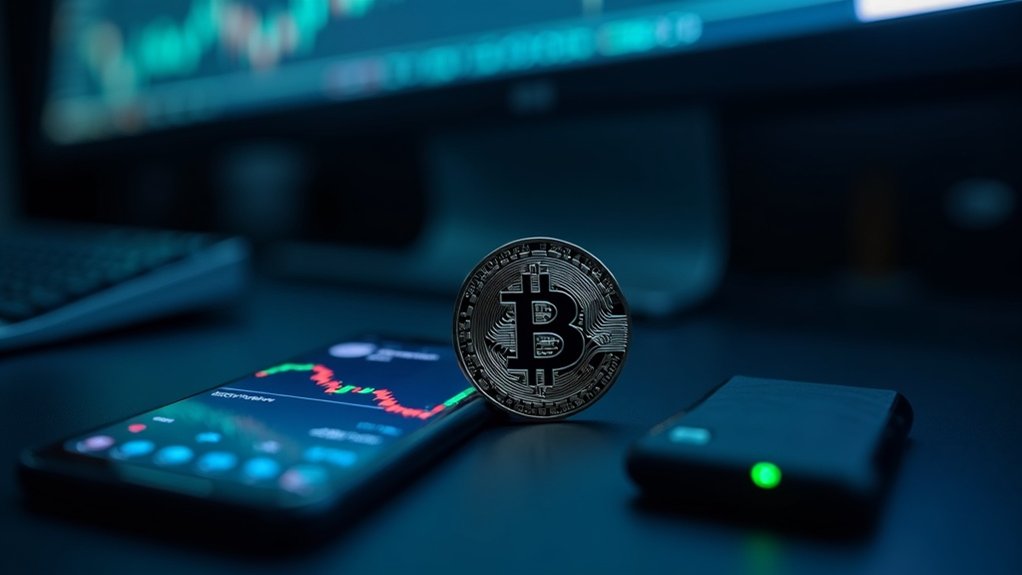Crypto yield farming puts digital assets to work in DeFi protocols, earning rewards through liquidity pools. Users deposit token pairs, receive LP tokens, and can stake these for additional earnings—typically in governance tokens. Not all sunshine though. Risks include impermanent loss, smart contract vulnerabilities, and volatile token values. Returns fluctuate with market conditions, often dramatically. Higher Total Value Locked (TVL) generally indicates more stable protocols. The real money’s in the details.
The crypto world never sleeps. And neither do yield farmers, those savvy crypto holders looking to make their digital assets work overtime. Yield farming—sometimes called liquidity mining—is fundamentally putting cryptocurrency to work in DeFi protocols to earn rewards. Simple concept, complex execution.
While markets rise and fall, yield farmers tirelessly put their crypto to work, harvesting DeFi rewards 24/7.
Here’s how it works: users deposit their tokens into liquidity pools on decentralized exchanges or lending platforms. These pools are fundamentally massive reserves of paired cryptocurrencies locked in smart contracts. In return, depositors receive LP (liquidity provider) tokens representing their share of the pool. Automated Market Makers maintain price stability through algorithmic formulas based on pool supply and demand.
These LP tokens? They’re not just receipts. They can be staked again in corresponding farms for additional rewards. Double-dipping, crypto style.
The rewards typically come in the form of governance tokens—the native currency of whatever protocol you’re using. These tokens accrue in real-time or per block, creating those eye-popping Annual Percentage Yields (APYs) that make traditional bank interest rates look like a sad joke. Tokens are typically locked in smart contracts that automatically distribute rewards when specific conditions are met.
Some farmers reinvest these tokens automatically to compound returns. Others swap them for different assets. Strategy matters.
Not all sunshine and rainbows, though. Impermanent loss is a real threat—that’s when your LP tokens decrease in value compared to if you’d just held the assets. Smart contract vulnerabilities? They exist. Hackers salivate over poorly audited protocols.
And those juicy reward tokens can plummet in value overnight, wiping out gains faster than you can say “rug pull.”
The metrics matter too. Total Value Locked (TVL) indicates how much capital is supplied to a protocol. Higher TVL generally means more liquidity and stability. Meanwhile, the APY advertised isn’t guaranteed—it fluctuates with market conditions.
Yield farming ultimately benefits the entire DeFi ecosystem by enhancing liquidity and reducing volatility. Yield farming differs from simple staking by requiring proactive adjustments to optimize returns as market conditions change. It’s democratizing finance and distributing governance rights to users. Revolutionary? Maybe. Risky? Definitely. But for those willing to navigate the complexity, the rewards can be substantial.
Frequently Asked Questions
What Are the Tax Implications of Yield Farming?
Yield farming comes with serious tax baggage.
Farmers face income tax on rewards at fair market value when received – that’s right, before even selling.
And it gets worse. Every swap or sale triggers capital gains calculations.
The recordkeeping nightmare is real – tracking values across countless transactions.
Different countries have different rules too.
No unified guidance exists specifically for yield farming.
Tax authorities are playing catch-up with DeFi innovation.
Not fun stuff.
How Much Capital Should Beginners Invest in Yield Farming?
Beginners should stick to small amounts in yield farming. Less than 5% of their crypto holdings. Period.
Most experts suggest a few hundred to a few thousand dollars – whatever they can afford to lose completely. Smart contracts fail. Impermanent loss happens. Those juicy high-yield pools? Often the riskiest.
Starting with stablecoins reduces the volatility headache.
Diversify across platforms instead of going all-in somewhere. And don’t forget to budget for those pesky gas fees.
Can Yield Farming Protocols Be Insured Against Hacks?
Yes, yield farming protocols can be insured against hacks. Companies like Nexus Mutual, Cover Protocol, and InsurAce offer specialized coverage for smart contract vulnerabilities.
Not cheap though. Insurance typically covers losses from bugs and exploits—not market risks like impermanent loss. Coverage depends on the protocol’s risk profile and audit history.
Big limitation? These decentralized insurance pools have limited capacity for large-scale hacks. And they often exclude certain attack vectors like oracle manipulations.
Better than nothing.
How Do Impermanent Loss Calculators Work?
Impermanent loss calculators compare what you’d earn holding tokens versus providing liquidity.
Simple math, really. They take your initial token amounts and prices, then simulate what happens when prices change. Using the AMM formula (x * y = k), they calculate how the pool rebalances tokens.
Then—bam!—they show the percentage difference. Spoiler alert: bigger price swings mean bigger losses.
These calculators don’t typically include fees or rewards. Those are separate considerations.
Which Wallets Are Safest for Yield Farming Activities?
For yield farming, hardware wallets like Ledger and Trezor lead the security pack. Period.
They keep private keys offline—crucial when DeFi protocols have bullseyes on their backs. Many farmers use this setup: hardware wallet for storage, connected to MetaMask for actual farming operations.
Trust Wallet offers decent mobile flexibility. Phantom works well in the Solana ecosystem.
Self-custody always beats custodial options, obviously. No wallet’s perfect though—smart contract risks remain regardless.








